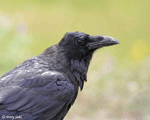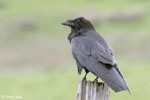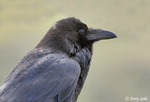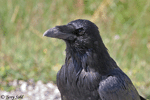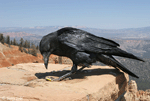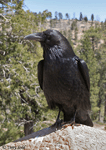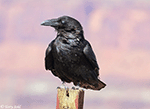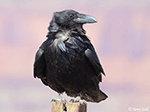| Length: 25 inches | Wingspan: 50 inches | Seasonality: Rare Visitor |
| ID Keys: Large size, very thick bill, wedge-shaped tail | ||
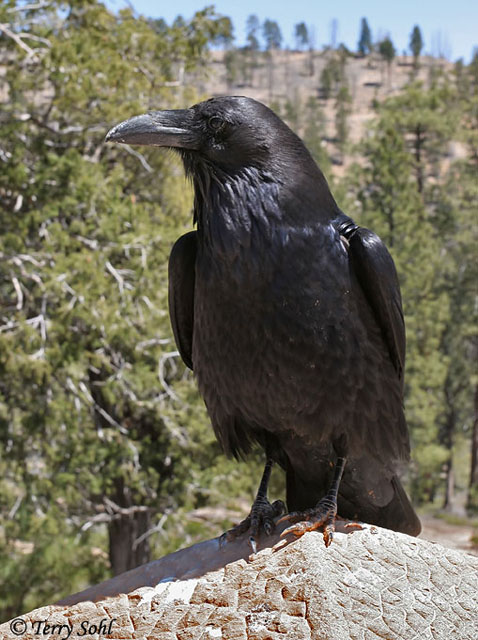 Common Ravens are the largest of the songbirds
(perching birds), with a distribution across the northern Hemisphere, including
Europe and Asia. Ravens are considered among the most adaptable and
intelligent of birds, traits which allow them to live in environments ranging
from tundra to forest to desert. The resourceful Raven is often seen
cooperating with others of its kind to capture prey. Ravens were probably
historically found throughout South Dakota, but unfortunately are now only rare
visitors. The Common Raven is, however, expanding its range into other
formerly inhabited areas.
Common Ravens are the largest of the songbirds
(perching birds), with a distribution across the northern Hemisphere, including
Europe and Asia. Ravens are considered among the most adaptable and
intelligent of birds, traits which allow them to live in environments ranging
from tundra to forest to desert. The resourceful Raven is often seen
cooperating with others of its kind to capture prey. Ravens were probably
historically found throughout South Dakota, but unfortunately are now only rare
visitors. The Common Raven is, however, expanding its range into other
formerly inhabited areas.
Habitat: Common Ravens will utilize a very wide variety of habitats. They are most often found in forested lands, but are also found in habitats ranging from the dry desert habitats of the southwestern US, to grassland and shrublands of the west, to the open Tundra of far northern North America.
Diet: Omnivorous. An incredibly wide array of items are eaten, including insects, worms, rodents, snakes, lizards, frogs, tadpoles, salamanders, birds, eggs, small fish, carrion, and garbage.
Behavior: Extremely variable in behavior, with individual birds or pairs of birds exhibiting behaviors suited to local conditions. They have adapted extremely well to a human presence, and in many locations can be seen foraging in around human dwellings and developments. Common Ravens overall are clever and resourceful, with their intelligence often manifesting itself in what looks like "play", including incredibly acrobatic flights, and teasing each other and other animals.
Nesting:
Currently a non-breeder in South Dakota, although they likely bred here historically. In breeding range, the nest is built on a cliff face, in a tree, or on man-made objects such as bridges or towers. The nest itself is a large basket built of sticks, lined with grasses, weed stems, bark fibers, and mosses. Nests may be re-used many years in a row, although it may be different nesting pairs that move in and renovate each year. The female lays between 3 and 7 eggs, and the female does most of the incubation, with the male bringing food to the female during this time. When the eggs hatch, both parents help to feed the young. The young leave the nest after about 40 days.
Song:
Common Ravens have an incredibly wide array of vocalizations, and even have the ability to mimic other birds. The most commonly heard vocalization is a harsh croaking call with a deeper and more hoarse tone than that of an American Crow.
- Click here to hear the typical call of a Raven1
- Click here to hear the calls of two Ravens in flight2
- Click here to hear a Common Raven scolding a Cooper's Hawk3
- Click here to hear a "hickup" call of a Common Raven4
- Click here to hear a more unusual "song" of a Common Raven5
Migration:
Generally a permanent resident throughout its range.
Interactive eBird Map:
Click to access an interactive eBird map of Common Raven sightings
Similar Species:
Common Ravens could potentially be confused with the following species in North America:
- American Crow - The bird most often confused for a Common Raven, American Crows are widely distributed across North America and could appear anywhere a Common Raven could. In appearance, American Crows are smaller, but size is difficult to judge from a bird in isolation. American Crows have a smaller bill, and lack the shaggy throat and bill feathering of a Common Raven. In flight, American Crows have a slightly rounded off tail compared to the much more wedge-shaped tail of a Common Raven.
- Chihuahuan Raven - Chihuahuan Ravens have a limited range in the United States, being found in the southwestern Great Plains, westward through parts of the Desert Southwest. In terms of appearance, they are extremely difficult to tell apart from a Common Raven. They are slightly smaller, but the best way to differentiate them is by voice, with Chihuahuan Ravens having higher-pitched calls than those of a Common Raven. Habitat is also often a clue in the areas where their ranges overlap, as Chihuahuan Ravens are more often found in dryer lowlands and Common Ravens are more often found in higher-elevation areas with substantial woodland and other vegetation.
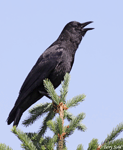 |
 |
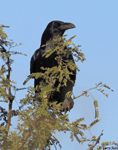 |
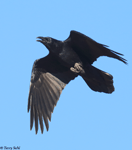 |
| American Crow | American Crow | Chihuahuan Raven | Chihuahuan Raven |
Conservation Status:
Ravens were exterminated from much of their former range in the Plains, Midwest, and Eastern United States. They are now expanding in range and numbers, especially in the Northeastern United States and in the Appalachians They remain a rare visitor to South Dakota, but sightings do seem to be increasing in recent years. On a global basis, the Common Raven is considered a species of "Least Concern" by the IUCN.
Further Information:
Photo Information:
May 2nd, 2008 - Bryce Canyon National Park, Utah - Terry Sohl
Additional Photos:
Click on the image chips or text links below for additional, higher-resolution Common Raven photos.
Audio File Credits:
- 1Jasper Barnes. Recorded in Santa Cruz County, California on June 24th, 2020. Original recording and information available from xeno-canto.
- 2Richard E. Webster. Recorded in Hidalgo County, New :Mexico on March 14th, 2020. Original recording and information available from xeno-canto.
- 3Randy Dzenkiw. Recorded in Victoria, British Columbia on June 16th, 2019. Original recording and information available from xeno-canto.
- 4Stein O. Nilsen. Recorded in Finland on June 20th, 2015. Original recording and information available from xeno-canto
- 5Richard Hoyer. Recorded in the Atascosa Mountains of southern Arizona on December 22nd, 2012. Original recording and information available from xeno-canto
| Click on the map below for a higher-resolution view |
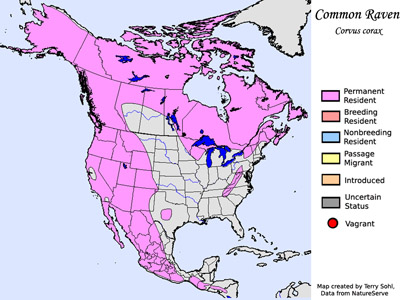 |
| South Dakota Status: Rare visitor. Most sightings have been in and around the Black Hills, but they have been sighted elsewhere in the state as well. Sightings appear to be increasing in recent years. |
Additional Common Raven Photos
Click for a higher-resolution version of these photos

